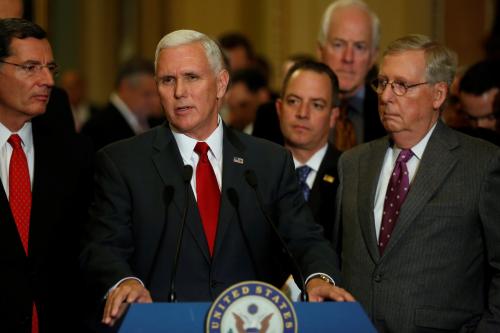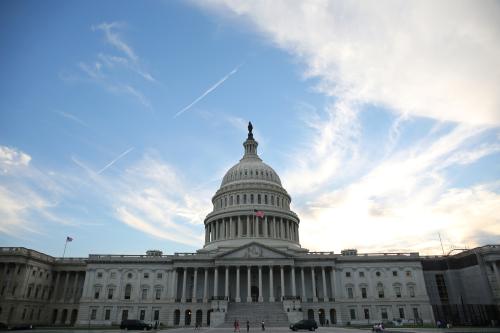With Senate Majority Leader Mitch McConnell (R-Ky.) planning to try to begin debate on the Republican health care bill Tuesday, lots of eyes will be on the chamber—a place famous for its complicated rules and jargon. Want to understand what’s happening? Here are four things you might see—and why they matter.
Motion to proceed
When the Senate wants to bring an item up for debate on the floor, it generally does so in one of two ways. The first involves the agreement of all 100 senators to start considering the bill. The second involves a senator (usually the Majority Leader) asking for permission to move on to debating a particular measure; this is known as “offering a motion to proceed.” On most legislation, the motion to proceed can be filibustered; in the 114th Congress, for example, 34 of the 128 cloture motions filed were on motions to proceed.
Reconciliation bills, however, are different. Preventing debate—and thus the possibility of a filibuster—on the motion to proceed is one part of the overall expedited process for considering reconciliation legislation. Think of it this way: it wouldn’t much matter if a reconciliation bill itself could not be filibustered if the motion needed to start talking about the bill could be.
In the past, when the Senate has considered a reconciliation bill, it has done so without having a vote on the motion to proceed. Two recent exceptions were in 2007 and 2010, and a vote will also be required this year. The motion will need a simple majority of those present and voting to pass. If all 52 Republicans are present, two could vote against the motion and, as long as Vice President Mike Pence is available to break a tie, it would pass and debate would begin. If Senator John McCain (R-Ariz.) or one other Republican senator is absent, however, Republicans can only lose one vote. In that situation, a second no vote would mean the motion would fail—and no successful motion to proceed means there’s no debate on the underlying bill.
Full text substitute
If debate begins, you may hear lots of discussion about McConnell offering a “full text substitute.” This is because the Senate isn’t actually bringing up its own bill on the floor. Rather, the Senate will use the bill passed by the House as its basis for debate. At some point in the process, McConnell will likely offer an amendment that deletes all the language from the House bill and inserts—or “substitutes”—some other text instead. At this point, it remains unclear exactly what that alternative proposal will be—or whether McConnell will offer more than one option. This ambiguity is part of why it may be hard to get senators to agree to begin debate, as they may be unwilling to set themselves up to cast votes they would rather not take. Ultimately, the Senate may cast votes on some version of the legislation that McConnell and a group of senators have been working on in recent weeks or on something that looks more like the partial Obamacare repeal bill the Senate passed in 2015. In addition, there’s been a lot of discussion about when exactly in the course of the process McConnell plans to offer his final, alternative proposal, including the possibility that he may wait until the very end if he believes doing so will increase the chances of ultimate passage. As a result, he’ll be the person to pay closest attention to on the floor.
Point of order
In general, the Senate’s rules aren’t self-enforcing. In order for something to be held as a breach of the chamber’s rules, a senator must first raise an objection on the floor, claiming the rules are being broken. This process of asserting a violation is called raising a “point of order,” and if debate begins, we are likely to see numerous points of order raised. One particular area of emphasis will be the Byrd Rule, which restricts the content of bills considered under the reconciliation process. If the presiding officer—a role fulfilled by either a senator or the vice president—agrees with a senator who raises a point of order and holds that a provision is in violation of the Byrd Rule, his decision can be overturned by three-fifths of the Senate. The Byrd Rule can also be waived—that is, the Senate can affirmatively decide not to enforce the Byrd Rule in a particular case—but that, too, requires a vote of three-fifths of the chamber.
Vote-a-rama
It’s widely known that reconciliation bills can’t be filibustered. Why not? The Congressional Budget Act (CBA) places an overall time limit on their debate. Because, however, “debate” is not equal to “consideration,” senators may continue offering and dispensing with amendments after the 20 hour limit has expired. This practice of calling up amendments and dispensing of them back-to-back, one after another, is colloquially known as the “vote-a-rama,” and if debate begins on Tuesday, a vote-a-rama on this bill is likely. Some opponents of the bill have advocated a “death by vote-a-rama” strategy, whereby Democrats continue to offer amendments in order to exhaust the GOP. This would be unlikely to succeed, since Republicans could likely use procedural maneuvers to end the process. The vote-a-rama also helps explain why consideration of reconciliation bills can be all-night affairs. Since 1987, the Senate has taken 17 recorded votes on passage of its version of reconciliation legislation, and seven of them have come after 10 PM. Late nights would be likely again this year.
The Brookings Institution is committed to quality, independence, and impact.
We are supported by a diverse array of funders. In line with our values and policies, each Brookings publication represents the sole views of its author(s).








Commentary
What to expect when you’re expecting a reconciliation bill
July 24, 2017